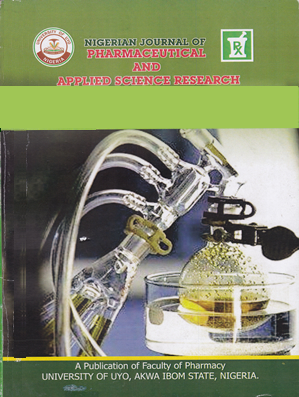Antibacterial Activities of Some Mixed Salicylic Acid- Vitamin C Metal Complexes
Contenu principal de l'article
Résumé
The increase of resistant bacteria was found to reduce the efficiency of antimicrobial therapies with the current antibiotics for more efficient drugs for the treatment of infections. Most studies have demonstrated an increase in antimicrobial activity following the interaction of several compounds with metal drug complexes. This study used a methodology adapted for antimicrobial bioassays for plant extracts, in compliance with the standards of the Clinical and Laboratory Standards Institute against Gram-positive and Gram-negative bacteria. Mixed metal drug complexes of Salicylic acid – Vitamin C were prepared and characterised by physico-chemical techniques such as melting point determination, Conductivity measurements and Infrared spectroscopy. The new alternative complexes possessed antimicrobial activity against some isolated organisms: Eurobacter aerogenes, Escherichia coli, Staphylococcus aureus, Serrate marcereus, Bacillus megaterium, Bacillus subtilis, Pseudomonas aeruginosa and Proteus vulgaris. The highest efficacy was shown by CuSO4 complex against Proteus vulgaris (25 mm) while the least inhibition was shown by Salicyclic acid against Pseudomonas Aeroginosa (11 mm). Some of them showed significant activity compared to their parent ligands i.e. NiCl2 against E. coli, and Bacillus subtilis (20 mm and 24 mm); CdSO4 against Serrate marcereus, Bacillus megaterium, Bacillus subtilis and Pseudomonas aeruginosa (24 mm, 20 mm, 21 mm and 22 mm); CuSO4 against E. coli, Serrate marcereus, and Bacillus megaterium (23 mm, and 24 mm); and CoSO4 against E. coli, Staphylococcus aureus and Proteus vulgaris (20 mm).
Téléchargements
Renseignements sur l'article

Cette œuvre est sous licence Creative Commons Attribution - Pas d'Utilisation Commerciale - Pas de Modification 4.0 International.
Références
Adediji, J.F. Olayinka, E.T. Adebayo, M.A., Babatunde, O. (2009). Antimalarial mixed ligand metal complexes: Synthesis, Physicochemical and Biological activities”. International Journal of Physical Sciences. 4 (9): 529-534.
Aiyelabola, T. O., Ojo, I.A., Adebajo, A.C., Ogunlusi, G.O., Oyetunji, O., Akinkunmi, E.O., Adeoye, A.O. (2012). Synthesis, characterization and antimicrobial activities of some metal(II) amino acids’ complexes. Advances in Biological Chemistry, 2, 268-273.
Farrar, K.M., Krcmar, M., Nowak, K. (2006). Reviews of Physiology, Biochemistry and Pharmacology.151: 45-91.
Masunari, A., Tavares, L.C. (2007). 3D QSAR studies of 5-nitrothiophene derivatives with antimicrobial activity against multidrug-resistant Staphylococcus aureus. Brazilian Journal of Pharmaceutical Sciences. 43(2), pp 256-268.
Mohammed, G.G. Abdel-Wahab, Z.H. (2005). Mixed ligand complexes of bis (Phenylimine) Schiff base ligands incorporating pyridinium moiety: Synthesis, characterization and antibacterial activity.SpectrochimicaActa. Part A: Mole. Biomole.Spect. 9(61): 2231-2238.
Mukamel, S. (2000). Multidimensional femtosecond correlation spectroscopies of electronic and vibrational excitations.Annu. Rev. Phys. Chem. 51: 691-729.
Obaleye, J.A. Famurewa, O. (1989). Inhibitory effect of some inorganic Boron trifluoride complexes on some microrganisms. Bios. Res. Comm. 1: 87-93.
Paula Atkins, P.P. Julio, de (2009). Elements of physical chemistry. 5th ed. Oxford: Oxford UP 459.
Rocha, D.P., Pinto, G.F., Ruggiero, R., Oliveira, C.A., Guerra, W.,Fontes, A.P.S., Tavares, T.T., Marzano, I.M., Pereira-Maia, E.C., 2011. Coordination of metals to antibiotics as a strategy to combat bacterial resistance. J. Inorg. Biochem. 34: 111-118.
Schaechter, M., Engleberg, N.C., Eisenstein, B.I., Medoff, G., 2002.Microbiologia. 3. ed. Guanabara Koogan: Sao Paulo. p. 120-127.
Siddiqui, F, A., Araye, M.S., Sultana, N., Qureshi, F. Mirza, A.Z. (2010). Spectroiphotometric determination of gabapentin in Pharmaceutical formulations using ninhydrin and pi-acceptors.Eur. J. Med. Chem. 45: 2761-2767.
Tella, A.C., Obaleye, J.A. (2010). Synthesis and Biological studies of Co(II) and Cd(II) 5-(3,4,5-trimethoxybenzyl) pyrimidine -2-4-diamine (Trimethoprim) complexes. Int. J. Biol. Chem. Sci. 4(6): 2181-2191.
Teslyuk, O.L., Beltyukova, S.V. Yegorova, A.V. Yagodkin, B.N. (2007).Complex compounds of terbium (III) with some nonsteroidal anti-inflammatory drugs and their analytical applications. Journal of Analytical Chemistry.62(4), pp 330–335.
Tortora, G.J., Funke, B.R., Case, C.L., 2003. Molecular Biology 4th. Ed. Porto Alegre: Artmed.
WHO, 2012. Promoting Access to Medical Technologies and Innovation Intersections between public health, intellectualproperty and trade. World Health Organization, World. Antimicrob. Agents Ch. 49, 2474 - 2478.Cienc. Farm. 42, 461-471.
.
Willey, J.M., Sherwood, L.M., Woolverton, C.J., 2008. Prescott, Harley, and Klein’s microbiology.McGraw-Hill, New York, NY,USA,


